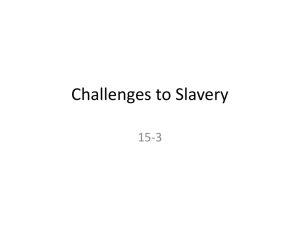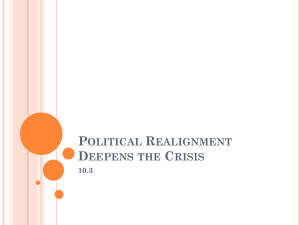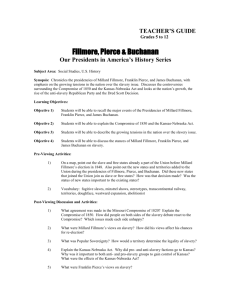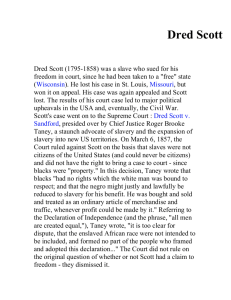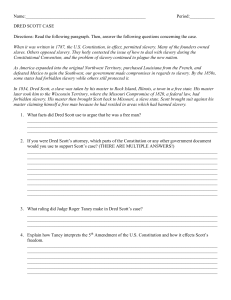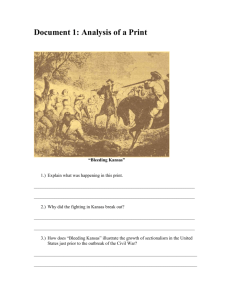America Under Franklin Pierce and James Buchanan, 1853-1860
advertisement
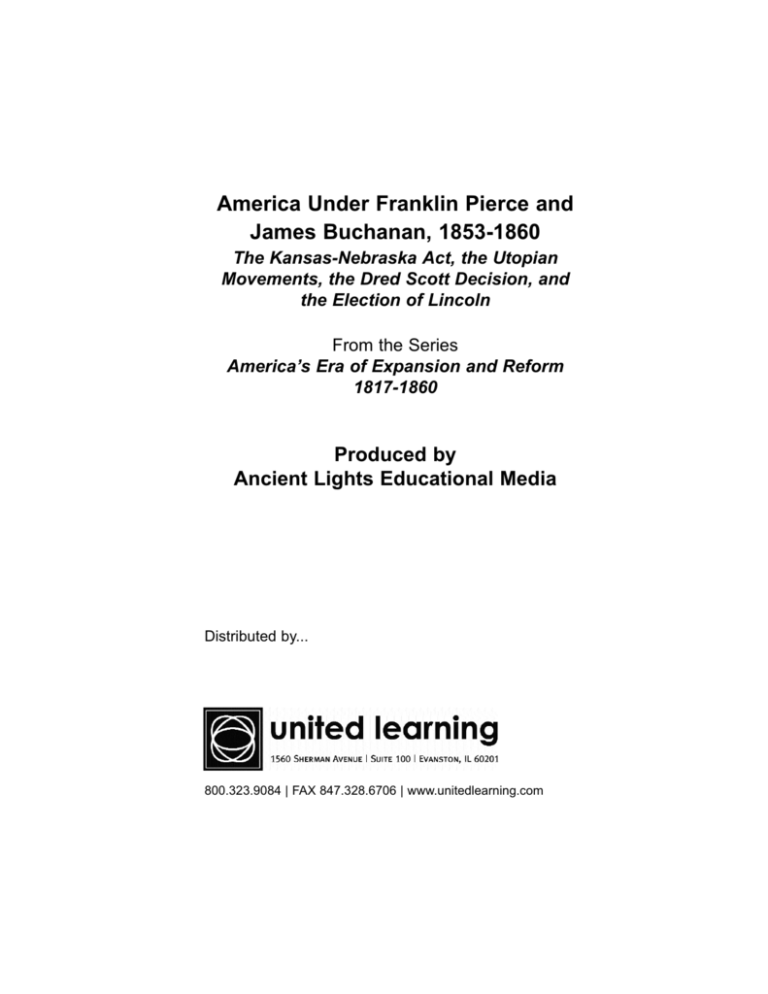
America Under Franklin Pierce and James Buchanan, 1853-1860 The Kansas-Nebraska Act, the Utopian Movements, the Dred Scott Decision, and the Election of Lincoln From the Series America’s Era of Expansion and Reform 1817-1860 Produced by Ancient Lights Educational Media Distributed by... 800.323.9084 |FAX 847.328.6706 |www.unitedlearning.com This video is the exclusive property of the copyright holder. Copying, transmitting, or reproducing in any form, or by any means, without prior written permission from the copyright holder is prohibited (Title 17, U.S. Code Sections 501 and 506). © 2003 Ancient Lights Educational Media Table of Contents Introduction to the Series . . . . . . . . . . . . .1 Introduction to the Program . . . . . . . . . . . .1 Links to Curriculum Standards . . . . . . . . . .2 Instructional Notes . . . . . . . . . . . . . . . . . . .4 Pre-Test . . . . . . . . . . . . . . . . . . . . . . . . . . .4 Student Preparation . . . . . . . . . . . . . . . . . .4 Student Objectives . . . . . . . . . . . . . . . . . .5 Introducing the Program . . . . . . . . . . . . . .5 View the Program . . . . . . . . . . . . . . . . . . .6 Discussion Questions . . . . . . . . . . . . . . . .6 Description of Blackline Masters . . . . . . . .6 Extended Learning Activities . . . . . . . . . . .7 Answer Key . . . . . . . . . . . . . . . . . . . . . . . .7 Script of Narration . . . . . . . . . . . . . . . . . . .10 This video is closed captioned. The purchase of this program entitles the user to the right to reproduce or duplicate, in whole or in part, this teacher’s guide and the blackline master handouts that accompany it for the purpose of teaching in conjunction with this program, America Under Franklin Pierce and James Buchanan, 1853-1860: The KansasNebraska Act, the Utopian Movements, the Dred Scott Decision, and the Election of Lincoln. This right is restricted only for use with this program. Any reproduction or duplication in whole or in part of this guide and the blackline master handouts for any purpose other than for use with this program is prohibited. CLASSROOM/LIBRARY CLEARANCE NOTICE This program is for instructional use. The cost of each program includes public performance rights as long as no admission charge is made. Public performance rights are defined as viewing of a video in the course of face-toface teaching activities in a classroom, library, or similar setting devoted to instruction. Closed Circuit Rights are included as a part of the public performance rights as long as closed-circuit transmission is restricted to a single campus. For multiple locations, call your United Learning representative. Television/Cable/Satellite Rights are available. Call your United Learning representative for details. Duplication Rights are available if requested in large quantities. Call your United Learning representative for details. Quantity Discounts are available for large purchases. Call your United Learning representative for information and pricing. Discounts, and some special services, are not applicable outside the United States. Your suggestions and recommendations are welcome. Feel free at any time to call United Learning at 1-800-323-9084. America under Franklin Pierce and James Buchanan; 1853-1860: The Kansas-Nebraska Act, the Utopian Movements, the Dred Scott Decision, and the Election of Lincoln Viewing Time: 14 minutes with a one-minute, five-question Video Quiz INTRODUCTION TO THE SERIES This standards-based series of programs for grades 5-9 examines the period of expansion and reform that occurred in the United States starting with the presidency of James Monroe in 1817 and continued up to the election of Abraham Lincoln in 1860. The five programs in this series focus on key events that shaped the history of the United States from 1817 to 1860. Major topics examined are: • U.S expansion and how it affected American Indians and foreign powers. • How industrialization, immigration, expansion of slavery, and westward movement changed the lives of Americans and led toward regional tensions. • The extension, restriction, and reorganization of American political democracy. • The sources and character of cultural, religious, and social reform movements in the antebellum period. INTRODUCTION TO THE PROGRAM America under Franklin Pierce and James Buchanan, 18531860: The Kansas-Nebraska Act, the Utopian Movements, the Dred Scott Decision, and the Election of Lincoln presents the following topics: · The Presidency of Franklin Pierce, 1853-1857 · The Gadsden Purchase and the Kansas-Nebraska Act, 18531854 1 · An Era of Reform and Self Improvement · James Buchanan and the Dred Scott Decision, 1857 · The Lincoln-Douglas Debates, 1858 · The Election of President Abraham Lincoln and the Establishment of the Confederacy, 1860-1861 LINKS TO CURRICULUM STANDARDS The series of which this program is a part is correlated to the U.S. National History Standards, listed below (www.sscnet.ucla.edu) U.S. National History Standard 1 United States Territorial Expansion between 1801 and 1861, and how it affected relations with external powers and Native Americans. Standard 1A The student understands the international background and consequences of the Louisiana Purchase, the War of 1812, and the Monroe Doctrine. Standard 1B The student understands federal and state Indian policy and the strategies for survival forged by Native Americans. Standard 1C The student understands Manifest Destiny, the nation's expansion to the Northwest, and the Mexican-American War U.S. National History Standard 2 How the Industrial Revolution, increasing immigration, the rapid expansion of slavery, and westward movement changed the lives of Americans and led to regional tensions. Standard 2A The student understands how the factory system and the transportation and market revolutions shaped regional patterns of economic development. 2 Standard 2B The student understands the first era of American urbanization. Standard 2C The student understands how antebellum immigration changed American society. Standard 2D The student understands the rapid growth of "the peculiar institution" after 1800 and the varied experiences of African Americans under slavery. Standard 2E The student understands the settlement of the West. U.S. National History Standard 3 The extension, restriction, and reorganization of political democracy after 1800. Standard 3A The student understands the changing character of American political life in "the age of the common man." Standard 3B The student understands how the debates over slavery influenced politics and sectionalism. U.S. National History Standard 4 The sources and character of cultural, religious, and social reform movements in the antebellum period. Standard 4A The student understands the abolitionist movement. Standard 4B The student understands how Americans strived to reform society and create a distinct culture. Standard 4C The student understands changing gender roles and the ideas and activities of woman reformers. 3 INSTRUCTIONAL NOTES Before presenting this lesson to your students, we suggest that you preview the program, review the guide, and the accompanying Blackline Master activities in order to familiarize yourself with their content. As you review the materials presented in this guide, you may find it necessary to make some changes, additions, or deletions to meet the specific needs of your class. We encourage you to do so; for only by tailoring this program to your class will they obtain the maximum instructional benefits afforded by the materials. PRE-TEST Pre-Test is an assessment tool intended to gauge student comprehension of the objectives prior to viewing the program. Explain that they are not expected to get all the answers correct. You can remind your students that these are key concepts that they should focus on while watching the program. STUDENT PREPARATION Set up a Learning Center with images relevant to the topics presented in this program, such as: DA map of the Gadsden Purchase, maps depicting changes in U.S. territories and states 1853-1861, a map of the Butterfield stage route, a map of the first transcontinental railroad, and a map of the Oregon Trail. DPictures of Franklin Pierce, James Buchanan, Stephen Douglas, Fredrick Douglass, John Brown, Harriet Beecher Stowe, Harriet Tubman, William Lloyd Garrison, Ralph Waldo Emerson, Henry David Thoreau, and Abraham Lincoln. 4 STUDENT OBJECTIVES After viewing the program and completing the follow-up activities, students should be able to: • Discribe the Kansas-Nebraska Act. • Explain the Missouri Compromise. • Explain the Dred Scott Decision. • Describe the events the led up to the breakup of the Union of States and the outbreak of the Civil War. • Describe 19th century movements of reform and selfimprovement. • Explain the Gadsden Purchase. INTRODUCING THE PROGRAM This program could be introduced with a review of the Missouri Compromise, as its demise with the passage of the KansasNebraska Act had significant consequences in terms of further dividing the nation. The Missouri Compromise also played a key role in the Dred Scott Decision, in that Scott had based his plea for freedom on that law, but the Supreme Court declared that it had been unconstitutional. The period from 1853-1861 was a time when old territories gave rise to new states (Minnesota, Oregon, and Kansas) and many new territories. For example, the territories of Washington, Dakota, Colorado, Kansas, Nebraska, and Nevada were all created during this period. A brief review of the "rapid fire" territorial changes of this period would be useful. Discuss some of the many 19th century movements that were dedicated to reform and self-improvement. Duplicate and administer Blackline Master #1, Pre-Test. Remind your students that they are not expected to know all the answers. Suggest that they use these questions as a guide for taking notes on the key concepts while viewing the program. 5 VIEW THE PROGRAM Running Time: 14 minutes plus a one-minute, five-question Video Quiz. Hand out Blackline Master #3, Video Quiz. DISCUSSION QUESTIONS After viewing the program, you may find it helpful to discuss key concepts as a class. The following questions/statements may prove to be useful. You may also choose to use these topics to begin a discussion prior to viewing the program. · What did the Supreme Court say in its decision on the Dred Scott case? · Why did South Carolina decide to leave the Union of States? · Why were Northerners more opposed to slavery than Southerners? · What was the purpose of the Kansas-Nebraska Act, and how did it affect the expansion of slavery? DESCRIPTION OF BLACKLINE MASTERS Blackline Master #1, Pre-Test, is an assessment tool intended to gauge student comprehension of the objectives prior to viewing the program. Blackline Master #2, Post-Test, is an assessment tool to be administered after viewing the program and completing additional activities. The results of this assessment can be compared to the results of the Pre-Test to determine the change in student comprehension before and after participation in this lesson. Blackline Master #3, Video Quiz, is intended to reinforce the key concepts of the program following the presentation of the program. Student awareness that a Video Quiz will be given also helps promote attention to the program presentation. 6 Blackline Master #4, Crossword Puzzle, is a puzzle game based on information presented in the Vocabulary List. Blackline Master #5, Timeline and Activity, presents important chronological events from 1849 to 1861. Blackline Masters #6 and #7, Vocabulary List and Activity, includes important names, people, places, and terms relating to events that occurred during this era in history. EXTENDED LEARNING ACTIVITIES Field trips to historic sites are the best way to savor the flavor of America's early days. Research papers, oral reports, news reports, or PowerPoint® presentations could be done on the following subjects: 1. The Kansas-Nebraska Act 2. The U.S. Supreme Court and the Dred Scott Case 3. The Lincoln-Douglas Debates 4. Franklin Pierce 5. James Buchanan 6. Stephen Douglas 7. Establishing a railroad to the Pacific Ocean. ANSWER KEY Blackline Master #1, Pre-Test 1. True 2. True 3. False. It was a Supreme Court decision over slavery. 4. False. The Gadsden Purchase added much less land than the Louisiana Purchase. 5. False. The Shakers were communal religious groups active in 19th century America. 7 Blackline Master #2, Post-Test A. Fill in the blanks: 1. Gadsden Purchase 2. Sail around the tip of South America 3. Republican Party 4. Buchanan 5. Civil War B. What was the basis of the lawsuit filed by Dred Scott? 1. Dred Scott was a slave from Missouri. Back in the 1830s, his owner had taken him to live in the Minnesota Territory, a place where slavery was illegal under the Missouri Compromise. Scott contended that having lived in a free territory for some time entitled him to his freedom. C. Name three main Supreme Court rulings contained in the Dred Scott Decision. 1. Even though it had been repealed in 1854, the Missouri Compromise, by limiting a slave owners right to take his property (his slaves) into those regions, had been unconstitutional, so Scott had no legal basis for his case. 2. Slavery could not made illegal in new territories, such as Kansas and Nebraska, because restrictive laws represented unconstitutional interference with a slave owner's legal right to freely take his property (slaves) into the new territories. 3. People of African descent, whether free or slave, were not allowed to be citizens of the U.S.; thus, Dred Scott did not have a legal right to file a lawsuit in the first place. Blackline Master #3, Video Quiz 1. False. The land it added was in the southwest region. 2. False. It permitted slavery under the concept of "popular sovereignty." 3. False. It was a Supreme Court decision. 4. True 5. True 8 Blackline Master #4, Crossword Puzzle 1 2 3 G N A 4 D R E D S C O T S T A S 5 D A - N M N E E U S H A K E R S 9 S J E P 7 K K A N S A S 6 A S B B B R C O U H L C A I H A 8 F O R T S O U T H C A R O L E S U M T I N A N A O A C N N T I E R K I S T 10 S T E P H E N D O U G L A S Blackline Master #5, Timeline Activity 1. 1854 2. 1853 3. 1860 4. 1861 5. 1856 Blackline Master #7, Vocabulary Activity 1. secede 2. popular sovereignty 3. slavery 4. Missouri Compromise 5. Stephen Douglas 9 SCRIPT OF NARRATION America under Franklin Pierce and James Buchanan, 18531860: The Kansas-Nebraska Act, the Utopian Movements, the Dred Scott Decision, and the Election of Lincoln During the eight years before the outbreak of America's Civil War, two men, Franklin Pierce and James Buchanan, were inaugurated as Presidents of the United States. This was an extremely unsettled time in American history due to rising anger and frustration over the issue of the expansion of slavery. The nation was becoming increasingly divided between South and North; between fee state and slave state. And neither Pierce nor Buchanan was able to keep the Union from falling apart. The Presidency of Franklin Pierce, 1853-1857 Franklin Pierce, America's 14th President, was a lawyer and a Democrat from the state of New Hampshire. Before becoming President, Pierce had represented his state here in the nation's capitol in both the Senate and House of Representatives. And he had served as an officer in the Mexican War as well. After being elected President, Franklin Pierce had to confront two major national problems. One was the growing opposition to the expansion of slavery. And the other was a rising tide of prejudice against new immigrants who were arriving in the country each day by the thousands. But, in spite of these enormous problems, the era of Franklin Pierce was a time of great prosperity for the United States, due in part to the recent discovery of gold in California. It was a time when huge numbers of pioneers loaded their possessions into covered wagons and headed down the Oregon Trail to start new lives in the western wilderness; a time when paddlewheeled steamboats, loaded with bales of cotton and other goods, chugged majestically up and down America's great rivers; a time when big factories dominated much of life in the New England states by providing steady jobs for those willing 10 to work long hours at noisy machines. And it was also a time when some people were starting to plan new railroad routes that would soon span the entire North American continent. The Gadsden Purchase and The Kansas-Nebraska Act, 1853-1854 When President Franklin Pierce moved into the White House in 1853, only a few years had passed since the nation had acquired its lands along the Pacific Ocean. At that time, there was still no railroad line to the west coast. But people knew that as soon as one could be built, a cross-country trip could be made in less than a week. As it stood, most passengers and trade goods from the Atlantic Coast had to travel by ship around the tip of South America, so that a voyage of several months was required to reach the harbor of San Francisco from eastern ports. Back then, land surveyors believed that one of the most practical routes for a railroad to California would pass through the hot desert land south of the Gila River in today's state of Arizona. However, in early 1853, that land still belonged to Mexico. But later that year, Mexican President Antonio Lopez de Santa Anna sold America this region, called the Gadsden Purchase, for $10 million. And, as a result of the Gadsden Purchase, over 29,000 square miles of land, or nearly 77,000 square kilometers, were added to the country. While new land was being acquired for a southern railroad route, Illinois Senator Stephen A. Douglas proposed the creation of a northern railroad route to the Pacific that would run west from the growing city of Chicago. Douglas knew that a northern railroad route would be of great financial benefit to his home state of Illinois. And, a northern railroad route would run through the unorganized territory in the center of the country, bringing rapid settlement to that area as well. Back then, this region was home to several large Native-American tribes and the huge herds of buffalo upon which they depended for food. To win the approval of voters from the southern slave states for a northern railroad route, the creation of two new territories, Kansas and Nebraska, was proposed. Douglas wanted them to 11 be places where popular sovereignty would exist, meaning that if the settlers in these territories wanted slavery, they could have it. And so, with the passage of the Kansas-Nebraska Act in 1854, the Missouri Compromise, the law that had kept slavery out of the North for 34 years, was repealed. In response to its passage, a group of people in Wisconsin founded the Republican Party. Its main purpose was to support politicians, like Abraham Lincoln, who sought to end slavery in America. An Era of Reform and Self-Improvement People who struggled to bring an end to slavery, such as the abolitionist William Lloyd Garrison, and ex-slaves Harriet Tubman and Fredrick Douglass, were typical of the countless reformers that were active in America during the first half of the nineteenth century. These reformers—both men and women— worked hard, not only to rid the nation of the evils of slavery, but also to improve education, improve the lives of the poor, improve conditions in the factories, improve the treatment of the mentally ill, improve the rights of women, and so forth. Some reformers even established ideal communities where people came to improve themselves by living and working together in peace and harmony. For they believed that if the conditions under which people lived were improved, ordinary human beings could accomplish truly amazing things. For example, a religious group known as the Shakers founded several ideal communities that, at one time, were home to as many as 6,000 people. Here at Pleasant Hill in Kentucky, hundreds of Shakers shared housing and meals, and practiced nonviolence, purity, and equality. James Buchanan and the Dred Scott Decision, 1857 In 1857, while the reformers worked to improve American society, James Buchanan, a Democrat from Pennsylvania, took the oath of office as America's 15th President. Only two days after President Buchanan was inaugurated, Supreme Court Chief Justice Roger Taney issued a series of rulings called the Dred Scott Decision that would come to have a tremendous impact on the future of the United States. 12 Dred Scott was a slave from Missouri. He had filed a lawsuit asking the Court to grant him his freedom on the grounds that, many years earlier, his owner had taken him to live for an extended period in a territory where slavery was illegal under the Missouri Compromise. This was the 1820 law, repealed in 1854, that had permitted slavery in Missouri as long as it was outlawed in territories north of what was called the Missouri Compromise Line. When they issued the Dred Scott Decision, the U.S. Supreme Court ruled that the Missouri Compromise had been unconstitutional because it had illegally deprived slave owners of their right to own a certain kind of property, that is, their slaves, in the northern territories. In other words, the Court said that Dred Scott had based his case on an unconstitutional law and thus, it had no merit. In addition, the Supreme Court went on to repeal laws that restricted the rights of American citizens to own slaves in the new U.S. territories, such as Kansas and Nebraska. Furthermore, the Court ruled that blacks, even if they weren't slaves, were not allowed to be U.S. citizens. Therefore, they said, Dred Scott should never have been allowed to file a lawsuit in the first place. President Buchanan supported the decision in the Dred Scott case and it was hailed as a great victory for the pro-slavery forces of the South. But Northerners reacted to it angrily, calling it a "wicked and false judgment." And the Republican Party said that the Dred Scott Decision clearly showed that slave owners were plotting to use the Constitution to achieve their goal of expanding slavery in the United States. The Lincoln-Douglas Debates, 1858 In 1858, the year after the Dred Scott Decision was issued, Minnesota entered the Union as a free state; gold was discovered in Colorado; and the Butterfield Overland Stage Line began to operate a regular stagecoach service between Missouri and California, and the journey took three weeks. 13 Eighteen fifty-eight was also the year of the Lincoln-Douglas Debates over slavery that took place during the race for the U.S. Senate in Illinois. On one side was the Democratic candidate for Senator, Stephen Douglas. On the opposing side was Abraham Lincoln, the Republican senatorial candidate. Lincoln was opposed to slavery on the grounds that it was a great moral evil. Lincoln tried to convince voters that Stephen Douglas was not to be trusted because he was the man behind the Kansas-Nebraska Act that had made slavery possible in territories where it had been previously illegal. Douglas believed that American citizens should be free to decide if they wanted to have slavery without having government interference. He warned that Lincoln's ideas on racial equality were dangerous and misguided. In the end, Lincoln's moral stand against slavery brought him to the attention of the entire nation. But, even at that, Douglas won the race for Senator. And the next year, 1859, another free state, Oregon, was admitted to the Union as America's 33rd state. The Election of President Abraham Lincoln, the Establishment of the Confederacy, 1860-1861 Out of the four candidates that ran for President in the election of 1860, Abraham Lincoln of Illinois won the most votes. About a month after the election, fearing that Lincoln would bring about an end to slavery, South Carolina seceded, that is broke away, from the United States. At that time, President Buchanan was still in charge of the country, due to the fact that Lincoln's inauguration was still 10 weeks away. Buchanan didn't want to send troops to South Carolina and decided to wait to see what would happen next. In the meantime, another new state, Kansas, was admitted to the Union. Buchanan's decision not to use force in South Carolina proved to be a big mistake. Because before Lincoln's inauguration in March of 1861, six other slave states: Texas, Florida, Louisiana, Georgia, Alabama, and Mississippi, had seceded from the Union as well. They called themselves the Confederate States 14 of America. And by the end of the year, the Confederates would be joined by North Carolina, Tennessee, Arkansas, and Virginia as well. A few days after South Carolina broke away from the Union, a small garrison of U.S. army troops left Fort Moultrie, just outside of Charleston, and moved to Fort Sumter a short distance away, across the harbor. When South Carolina officials demanded that the U.S. troops leave Fort Sumter, they refused. In response, on April 12, 1861, Confederate troops opened fire on Fort Sumter as the citizens of Charleston watched on in horrified disbelief. And so began a four-year civil war that would bring about the deaths of 620,000 American soldiers. Video Quiz 1. True or False? The Gadsden Purchase added land to America's northwest region. 2. True or False? The Kansas-Nebraska Act outlawed slavery in the new U.S. territories. 3. True or False? The Dred Scott Decision ended America's Civil War. 4. True or False? President Buchanan decided not to use military force to keep the Union together. 5. True or False? The Republican Party was founded to help stop the spread of slavery. 15 16


